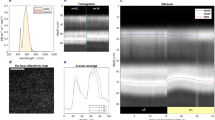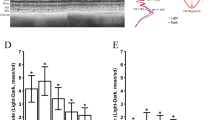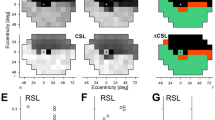Abstract
EXPOSURE of rats to continuous illumination leads to cellular deterioration within the retina and a concurrent reduction of electroretinogram (ERG) responses1,2. Grignolo et al.3 showed that at early stages, this ‘damage’ due to light is hypertrophic in that tubules and vesciculae appear in receptor cell outer segments. They surmised that losses in retinal functioning are initially due to disorganisation rather than degeneration. But, experiments on recovery from light damage2 indicate that ERG sensitivity returns as the rhodopsin-containing disks of the outer segments are regenerated even though their original lamellar structure is not restored. It is thereby implied that as long as visual pigment is present at functional sites, the normal structure of the outer segments may not be crucial to ERG responsivity. Here we describe an experiment which quantitatively examines the role of visual pigment remaining in the albino rat retina which has been exposed to continuous low-intensity light. The ERG sensitivity, rhodopsin content and morphological state of the retina were assessed for various exposure durations. Our findings indicate that reductions in visual pigment levels due to constant light persist indefinitely in the dark. Furthermore, the log ERG (b wave) sensitivity varied directly with the rhodopsin content of exposed retinas even as progressive deterioration was apparent. With respect to this log–lienar relationship, light damage resembles ‘normal’ light adaptation due to short term bleaching exposure.
This is a preview of subscription content, access via your institution
Access options
Subscribe to this journal
Receive 51 print issues and online access
$199.00 per year
only $3.90 per issue
Buy this article
- Purchase on Springer Link
- Instant access to full article PDF
Prices may be subject to local taxes which are calculated during checkout
Similar content being viewed by others
References
Noell, W. K., Walker, V. S., Kang, B. S. & Berman, S., Invest. Ophthalmol. 5, 450–473 (1966).
Kuwabara, T., Am. J. Opthamol. 70, 187–198 (1970).
Grignolo, A., Orzalesi, N., Castellazzo, R. & Vittone, P., Ophthalmologica 157, 43–49 (1969).
Kuwabara, T. & Gorn, R. A., Arch. Ophth. 79, 69–78 (1968).
Dowling, J. E., J. gen. Physiol. 46, 1287–1301 (1963).
Weinstein, G. W., Hobson, R. R. & Dowling, J. E., Nature 215, 134–138 (1967).
Dowling, J. E. & Wald, G., Proc natn. Acad. Sci. U.S.A. 46, 587–608 (1960).
Miller, R. F. & Dowling, J. E., J. Neurophysiol. 33, 323–341 (1970).
Author information
Authors and Affiliations
Rights and permissions
About this article
Cite this article
RAPP, L., WILLIAMS, T. Rhodopsin content and electroretinographic sensitivity in light-damaged rat retina. Nature 267, 835–836 (1977). https://doi.org/10.1038/267835a0
Received:
Accepted:
Published:
Issue Date:
DOI: https://doi.org/10.1038/267835a0
This article is cited by
-
Massive diurnally modulated photoreceptor membrane turnover in crab light and dark adaptation
Journal of Comparative Physiology ? A (1979)
Comments
By submitting a comment you agree to abide by our Terms and Community Guidelines. If you find something abusive or that does not comply with our terms or guidelines please flag it as inappropriate.



